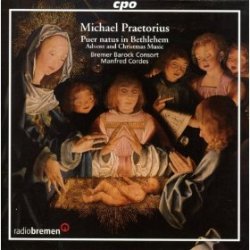Praetorius - Advent and Christmas Music
Praetorius - Advent and Christmas Music

1. Veni redemptor gentium / Nun komm der Heiden Heiland 2. In dulci jubilo 3. Vom Himmel hoch 4. Puer natus in Bethlehem 5. Conditor alme siderum 6. Gelobet seist du, Jesu Christ 7. Resonet in laudibus - Joseph, lieber Joseph mein Bremer Barock Consort Manfred Cordes – conductor
Michael Praetorius is best known to British music-lovers through his hymn arrangements, particularly at Christmas: the Advent hymn Come, Thou Redeemer of the Earth is his, as is the chorale Es ist ein Ros entsprungen, sometimes anglicised to Lo, how a rose e’er blooming. This is hardly surprising, as Praetorius grew up in the aftermath of the Reformation. His father had studied theology at Wittenberg under Luther himself and Michael was brought up in a piously Lutheran household, a faith he made his own. Throughout his life he repeatedly expressed his regret that he had not become a theologian and he interpreted his initials (MPC) to mean "Mihi Patria Coelum": Heaven is my fatherland.
He spent most of his life in the employ of various German princes and, while he composed a large amount of instrumental music for entertainment at court, it’s for his sacred music that he is best known, and this disc shows why. It collects together some of his music for the Advent season, and most attractive it is too. Each item is based around a German or Latin hymn: as one would expect, the hymn tune is repeated regularly and without variation throughout each piece, but it is seldom if every dull because of the ingenious accompaniments and variations that the composer spins around each stanza. Take track 3, based on the chorale Von Himmel hoch: first the theme is played by the ensemble (little more than a spare continuum group at this stage), then sung by the all four parts. Two sopranos sing the next stanza while two recorders dance around them, followed by a soprano soloist supported by a pair of complementary violas da gamba. And so it continues until the end of the hymn: each stanza undergoes a new treatment so we have the attraction of something new together with the reiteration of the steady chorale theme. In contrast to this come the more complex numbers such as Gelobet seist du Jesu Christ, which contains more complex counterpoint and has a more developmental role for the instruments. The variety ensures that the disc is never dull, in spite of the repetition.
Incredibly, the performers are all students at the Bremen College of Arts - conducted by their professor - specialising in this branch of early music. Incredible because the performances contain a polish and flair that would put some professional groups to shame. They have clearly benefited from studying together and growing closer as musicians as their rehearsals have developed. The ensemble itself is rather small: the chorus contains four sopranos and one each of alto, tenor and bass, while the instrumentalists are four recorders, four violas da gamba, one harp and an organ positive. This feels entirely right for the repertoire, however, and they show a most enjoyable lilt in the ever popular In dulci jubilo. Players and singers weave in and out of each other with complete security and togetherness, though there is an unaccompanied bass entry in Puer Natus where the music noticeably flattens.
All in all a great place to begin an exploration of Praetorius’ music. Next December, when you’re singing one of his hymns in church, spare him a thought: had he not been surpassed by the likes of Bach he deserves to be much better known. --- Simon Thompson, musicweb-international.com
Last Updated (Saturday, 04 February 2012 15:04)








